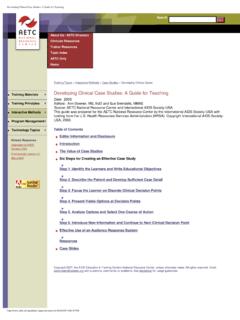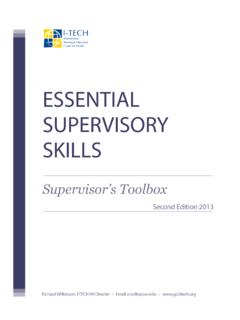Transcription of Training Evaluation Framework and Tools (TEFT) www ...
1 Training Evaluation Framework and Tools (TEFT) Step 5: Evaluation Design and Methods 1 of 16 Step 5: Choose Evaluation Design and Methods Tool: Design and Methods Example Tables Introduction: At this stage, you have reviewed the Training Evaluation Framework (Step 1), thought about your situational factors (Step 2), completed the Evaluation Considerations Tool (Step 3), refined your Evaluation questions, and begun to identify indicators (Step 4). You now have a good idea of the outcomes you intend to evaluate and the factors that may influence your Evaluation . This step will help you choose an Evaluation design that fits the goals and objectives of your Evaluation . It will also help you identify and choose between the many quantitative and qualitative methods available. Note that the purpose of this section is to briefly introduce you to a few key Evaluation designs and methods specifically used in Training Evaluation .
2 It is not a comprehensive review of research design and methods. Regardless of your level of expertise, as you plan your Evaluation it may be useful to involve another evaluator with advanced Training in Evaluation and research design and methods. Whether you are a highly Design and Methods Design refers to the overall structure of the Evaluation : how indicators measured for the intervention ( Training ) and non-intervention (no Training ) conditions will be examined. Examples include: experimental design quasi - experimental design Non- experimental design Methods refer to the strategies that are used to collect the indicator data. Examples include: Pre- and post-knowledge testing Survey Observation Training Evaluation Framework and Tools (TEFT) Step 5: Evaluation Design and Methods 2 of 16 experienced evaluator or new to the field, input from another expert can be useful as you finalize the Training Evaluation design and methods you ve chosen.
3 Your colleague can also assist you as you plan, develop Tools , and implement the Evaluation , and may help you plan for final analysis and report writing. Choosing your Evaluation design and methods is a very important part of Evaluation planning. Implementing strong design and methods well will allow you to collect high quality and relevant data to determine the effectiveness of your Training program. Without good data, it s impossible to infer a link between Training and outcomes. Your choice of design and methods will be influenced by the situational factors and considerations you addressed in Steps 2 and 3, and may help to mitigate the problems or potential confounders that you identified. Choosing Your Evaluation Methods: After spending some time on the Evaluation Considerations Tool and thinking about your program s Evaluation resources and sources of readily available data, begin to think about the possible methods that you might use to collect data on the indicators you ve chosen.
4 The table below outlines some methods you might use, selected because they are among the most common in the literature regarding Training outcomes. Note again that although the TEFT is presented as a series of steps, in reality, the process of thinking about Evaluation design and methods may not follow a straight line. It may instead be an iterative process, in which you come up with an idea and need to revisit previous steps, to see if it makes sense. For example, you might prefer to think about design before thinking about methods; this would work just as well. Training Evaluation Framework and Tools (TEFT) Step 5: Evaluation Design and Methods 3 of 16 Table 1. Possible Methods and Data Sources for Outcome Evaluation Methods, Tools Data Sources Type of Data Collected Written/oral responses: surveys questionnaires interviews journals Training participants ( trainees ) Content knowledge Attitudes, feelings Self-reports of trainees behavior Reports of perceived outcomes Patients Reports of provider behavior Self-report of patient understanding Self-report of patient feelings/behavior Self-report of patient health status Trainees co-workers, supervisors, and other contacts Reports of trainees behavior Reports of perceived outcomes Group feedback.
5 Focus groups Trainees, co-workers, supervisors, patients, stakeholders Perceptions regarding programs Perceptions regarding needs Perceptions regarding outcomes, changes notes, checklists Trained observers Observations of trainee behavior in the classroom or a simulated work setting Observations of trainee performance on the job Document review, data extraction Institutional/clinical records Records, documents Patient health data Provider, organization, or population-level performance data Training Evaluation Framework and Tools (TEFT) Step 5: Evaluation Design and Methods 4 of 16 Choosing Your Evaluation Design: You will need to choose a design that balances feasibility with an ability to help you infer a causal link between the Training and the outcome. In order to infer causality, you will need to compare data for the intervention ( Training ) with the non-intervention (no Training ).
6 Table 2: Possible Designs for Outcome Evaluation Design Type Examples Strengths Challenges experimental : Compares intervention with non-intervention Uses controls that are randomly assigned Randomized controlled trial (RCT) o Pre-post design with a randomized control group is one example of an RCT Can infer causality with highest degree of confidence Most resource-intensive Requires ensuring minimal extraneous factors Sometimes challenging to generalize to real world quasi - experimental : Compares intervention with non-intervention Uses controls or comparison groups that are not randomly assigned Pre-post design with a non-randomized comparison group Can be used when you are unable to randomize a control group, but you will still be able to compare across groups and/or across time points Differences between comparison groups may confound Group selection critical Moderate confidence in inferring causality Training Evaluation Framework and Tools (TEFT) Step 5: Evaluation Design and Methods 5 of 16 Table 2: Possible Designs for Outcome Evaluation Design Type Examples Strengths Challenges Non- experimental : Does not use comparison or control group Case control (post-intervention only).
7 Retrospectively compares data between intervention and non-intervention groups Pre-post with no control: Data from one group are compared before and after the Training intervention Simple design, used when baseline data and/or comparison groups are not available and for descriptive study. May require least resources to conduct Evaluation . Minimal ability to infer causality As you think about these options, it is very useful to consult with colleagues to get feedback on your proposed Evaluation level, questions, indicators, design, and methods. It will also be useful to walk though the Evaluation in your mind, reviewing the process of collecting the data and the resources that will be required to do this. Think about whether your plan will answer your questions, is feasible, and makes good use of your resources.
8 Training Evaluation Framework and Tools (TEFT) Step 5: Evaluation Design and Methods 6 of 16 Evaluation Designs and Methods Examples from Published Literature: Literature already published on Training outcome Evaluation provides some valuable insight into Evaluation design and methodology. The examples below explore Evaluation designs and methods that have been reported at the three levels of the Training Evaluation Framework : individual, organizational, and systems/population (Figure 1). Presented here are examples of experimental , quasi - experimental , and non- experimental designs and a range of methods, including interview, focus group, observation, written surveys and examinations, and clinical data review. For your reference, the corresponding literature is cited in the last page of this document. A full list of articles reviewed for the development of this Framework is also available on the TEFT website.
9 Evaluating Outcomes at the Individual Level: The examples in Table 3* present methods and designs from published articles. These articles reported on the effect of Training on individuals. As indicated in the Training Evaluation Framework , changes that could be evaluated include new knowledge, skills, and/or attitudes among the Training participants, changes in their on-the-job performance (as a result of this new knowledge), and changes in patient health (as a result of improved health care worker performance). The majority of Training evaluations which have been reported were conducted at this point in the causal pathway toward better health outcomes. * Notice that in the table, all outcomes are in color. The color of the text corresponds to its place in the Framework .
10 So, for example, the outcome skills and attitudes of health care workers is purple, because on the Framework , outcomes of this type are in the purple arrow. Keep an open mind Keep in mind that there is no single best design or best method; all designs and all methods are possibilities for each outcome level and category. Your choices will depend upon the outcomes you evaluate, the situational factors you identified in Step 2, and the considerations you addressed in Step 3. Training Evaluation Framework and Tools (TEFT) Step 5: Evaluation Design and Methods 7 of 16 Figure 1: Training Evaluation Framework Training Evaluation Framework and Tools (TEFT) Step 5: Evaluation Design and Methods 8 of 16 Table 3. Evaluation Designs and Methods for Measuring Changes at the Individual Level 1. Randomized Controlled Trial: An experimental design in which the individuals being studied ( , Training participants) are randomly assigned to either an intervention condition or a control condition.












